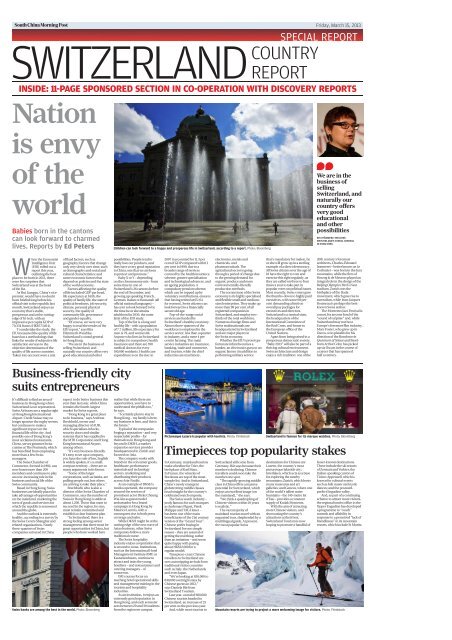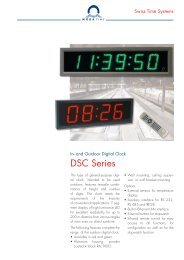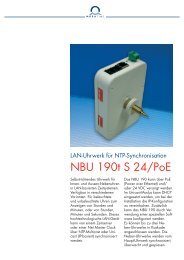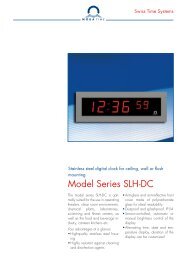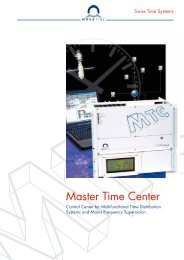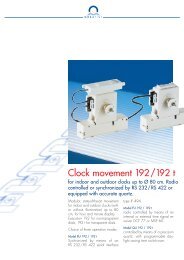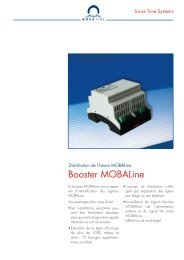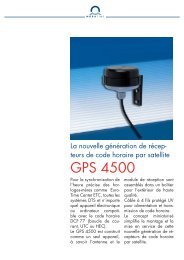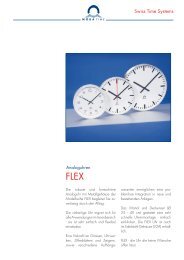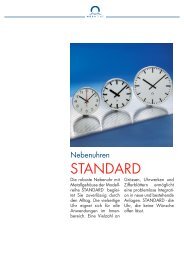Switzerland - MOBATIME Swiss Time Systems
Switzerland - MOBATIME Swiss Time Systems
Switzerland - MOBATIME Swiss Time Systems
You also want an ePaper? Increase the reach of your titles
YUMPU automatically turns print PDFs into web optimized ePapers that Google loves.
SWITZERLAND COUNTRYREPORTFriday, March 15, 2013SPECIAL REPORTINSIDE: 11-PAGE SPONSORED SECTION IN CO-OPERATION WITH DISCOVERY REPORTSNationis envyof theworldBabies born in the cantonscan look forward to charmedlives. Reports by Ed PetersChildren can look forward to a happy and prosperous life in <strong>Switzerland</strong>, according to a report. Photo: BloombergWe are in thebusiness ofselling<strong>Switzerland</strong>, andnaturally ourcountry offersvery goodeducationaland otherpossibilitiesRITA HÄMMERLI-WESCHKE,SWITZERLAND’S CONSUL GENERALIN HONG KONGWhen the EconomistIntelligence Unit(EIU) rolled out areport this year,outlining the bestplace to be born in 2013, therewere few surprises that<strong>Switzerland</strong> was at the headof the list.As Hui Liangyu, China’s vicepremier,would have no doubtbeen briefed long before hisofficial visit to the republic lastmonth, <strong>Switzerland</strong> enjoys aneconomy that’s stable,prosperous and at the cuttingedgeof hi-tech, with animpressive per capita GDP of70,334 francs (HK$573,814).To undertake the study, theEIU measured the quality of lifebased on a methodology thatlinks the results of subjective lifesatisfaction surveys to theobjective determinants of thequality of life across countries.Taken into account were a mixof fixed factors, such asgeography; factors that changeonly very slowly over time, suchas demography and social andcultural characteristics; andsome economic factors thatdepend on policies and the stateof the world economy.Factors affecting the qualityof life included GDP per head,life expectancy at birth, thequality of family life, the state ofpolitical freedoms, job security,climate, personal physicalsecurity, the quality ofcommunity life, governanceand gender equality.“Of course, we were veryhappy to read the results of theEIU report,” says RitaHämmerli-Weschke,<strong>Switzerland</strong>’s consul generalin Hong Kong.“We are in the business ofselling <strong>Switzerland</strong>, andnaturally our country offers verygood educational and otherpossibilities. People tend toreally love our products, andthey have a very good reputationin China, one that we are keento protect and promote.”Baby X or Y – dependingon the chromosome mix – bornsome time in one of<strong>Switzerland</strong>’s 26 cantons beforethe end of December, andgrowing up speaking French,German, Italian or Romansh (allofficial national languages) –has a lot to look forward to bythe time he or she attainsadulthood in 2030, the outerlimit of the EIU study.Top of the list is a long andhealthy life – with a populationof 7.7 million, life expectancy formen is 79, and women 84.Anyone who lives in <strong>Switzerland</strong>is subject to compulsory healthinsurance and there are 390medical doctors for every100,000 residents. Health careexpenditure is on the rise: in2007 it accounted for 11.3 percent of GDP compared with 8.1per cent in 1990, due to abroader range of servicescovered by the health insurancescheme, greater specialisationand technological advances, andan ageing population. Acompulsory pension scheme,which can be topped up byvoluntary contributions, ensuresthat having retired at 65 (64for women), <strong>Swiss</strong> citizens canlook forward to a financiallysecure old age.Top-of-the-range socialservices are funded by<strong>Switzerland</strong>’s healthy economy.Almost three-quarters of theworkforce is employed in theservice sector, less than a quarterin industry, and a mere 4 percent in farming. The mainservice industries are insurance,banking, trade and commerce,and tourism, while the chiefindustries are machinery,electronics, metals andchemicals, andpharmaceuticals. Theagricultural sector is goingthrough a period of change dueto the growing demand fororganic produce and moreenvironmentally-friendlyproduction methods.The cornerstone of the <strong>Swiss</strong>economy is its highly specialisedand flexible small and mediumsizedenterprises. They make upmore than 99 per cent of allregistered companies in<strong>Switzerland</strong>, and employ twothirdsof the total workforce.Numerous foreign firms and<strong>Swiss</strong> multinationals areheadquartered in <strong>Switzerland</strong>and are major players inthe <strong>Swiss</strong> economy.Whether the EIU’s prototypefortunate infant becomes abanker, an electronics guru or anorganic farmer (in addition toperforming military servicethat’s mandatory for males), heor she will grow up in a sterlingexample of a direct democracy.All <strong>Swiss</strong> citizens over the age of18 have the right to vote andexercise this right regularly, asthey are called on three to fourtimes a year to take part inpopular votes on political issues.Most recently, <strong>Swiss</strong> voters gavethe thumbs-down to highly paidexecutives, with some 68 percent demanding a limit onoverall pay packages forexecutives and directors.<strong>Switzerland</strong> is a neutral state,the headquarters of theInternational Committee ofthe Red Cross, and home tothe European office of theUnited Nations.Apart from being raised in aprosperous democratic society,“Baby 2013” will also be part of athriving cultural environment.<strong>Swiss</strong> architecture and designenjoy a rich tradition: one of the20th century’s foremostarchitects, Charles-ÉdouardJeanneret – better known as LeCorbusier – was born in the Juramountains, while the firm ofHerzog & de Meuron played anintegral role in the design of theBeijing Olympics Bird’s Neststadium. Zurich was thebirthplace of the Dadamovement, which gave rise tosurrealism, while Jean-JacquesRousseau is perhaps the bestknown<strong>Swiss</strong> author.The Montreux Jazz Festival isa must for anyone fond of the“sound of surprise” and, while<strong>Switzerland</strong> may not hostEurope’s foremost film industry,Marc Foster, who grew up inDavos, won plaudits for hisdirection of the Bond movieQuantum of Solace and BaselbornArthur Cohn has pickedup six Oscars in the course ofa career that has spannedhalf a century.Business-friendly citysuits entrepreneursIt’s difficult to find an area ofbusiness in Hong Kong where<strong>Switzerland</strong> is not represented.<strong>Swiss</strong> Airbuses are a regular sightat Hong Kong InternationalAirport. Credit Suisse may nolonger sponsor the rugby sevens,but continues to make asignificant impact on thefinancial life of the city. Andpossibly one of Hong Kong’smost acclaimed restaurants,Chesa, serves gourmet <strong>Swiss</strong>cuisine at The Peninsula, whichhas benefited from employingmore than a few <strong>Swiss</strong>managers.The <strong>Swiss</strong> Chamber ofCommerce, formed in 1982, cannow boast more than 200members and continues to playan ever-increasing role in thebusiness and social life of the<strong>Swiss</strong> community.Based in Hong Kong, <strong>Swiss</strong>businesses are ideally placed totake advantage of opportunitieson the mainland, marketing thesorts of goods and services forwhich the republic is renownedaround the globe.And the outlook is extremelyhealthy, according to a survey bythe <strong>Swiss</strong> Centre Shanghai andrelated organisations. Nearlythree-quarters of <strong>Swiss</strong>companies surveyed in Chinaexpect to do better business thisyear than last year, while Chinaremains the fourth-largestmarket for <strong>Swiss</strong> exports.“Hong Kong is a great placeto do business,” says AndreasBrechbuhl, owner andmanaging director of AUB,which specialises in locks,security doors and similarsystems that it has supplied tothe MTR Corporation and HongKong International Airport,among others.“It’s very business-friendly.It’s easy to set up a company,you have the rule of law, Englishis widely spoken, it’s a small,compact territory – there are somany arguments in its favour.“Some of the largercorporations, such as banks, arepulling people out, but othersare arriving to take their place.”Brechbuhl, who is also adirector of the <strong>Swiss</strong> Chamber ofCommerce, says the number of<strong>Swiss</strong> in Hong Kong is stable atabout 1,200. Those that want tosucceed in the region, he says,must remain committed andestablish a clear business plan.“In <strong>Switzerland</strong>, there is astrong feeling among seniormanagement that there must begreat opportunities in China, butpeople who have worked here<strong>Swiss</strong> banks are among the best in the world. Photo: Bloombergrealise that while there areopportunities, you have tounderstand the pitfalls too,”he says.“I certainly plan to stay inHong Kong – my family is here,my business is here, and this isthe future.”Typical of the companiesforging a reputation – and veryrespectable profits – forthemselves in Hong Kong andbeyond is DKSH, a marketexpansion services providerheadquartered in Zurich andfocused on Asia.The company works withbrands in the consumer goods,healthcare, performancematerials and technologysectors, marketing anddistributing their productsacross Asia-Pacific.As an example of DKSH’smodus operandi, the companysecured the services ofprominent actor Dicky CheungWai-kin as guest modelambassador for a brandcampaign in Hong Kong byMaurice Lacroix, with aconsequent rise in both presscoverage and sales.While DKSH might be at thecutting edge of the new wave ofAsian business, other <strong>Swiss</strong>companies follow a moretraditional course.The <strong>Swiss</strong> hospitalityindustry enjoys a reputation thatis second to none. Institutions,such as the International HotelManagement Institute (IMI) atKastanienbaum, continue toattract and train the younghoteliers – and restaurateurs andcatering managers – oftomorrow.IMI courses focus onteaching hotel operational skillsand management training in thetourism and hospitalityindustries.As an institution, it enjoys anextremely good reputation inHong Kong, and each semestersees between 20 and 30 studentsfrom the region on campus.Picturesque Luzern is popular with tourists. Photo: ThinkstockIn Germany, mainland touristsmake a beeline for Trier, thebirthplace of Karl Marx.In France, the wineries ofBordeaux are top of the mustsamplelist. And in <strong>Switzerland</strong>,China’s newly emergentglobetrotting middle classeshead straight for the country’scelebrated watch emporia.The <strong>Swiss</strong> watch industry –justly famous for such marquesas Audemars Piguet, PatekPhilippe and TAG Heuer –has been one of the mainbeneficiaries of the 21st centuryversion of the “Grand Tour”.Chinese prefer buying in<strong>Switzerland</strong> for one simplereason – they are assured ofgetting the real thing, ratherthan an imitation – and seemquite happy with payingabout HK$12,000 for aregular model.<strong>Time</strong>piece-crazy Chinesetravellers to <strong>Switzerland</strong> arenow outstripping arrivals fromtraditional visitor countriessuch as Italy, the Netherlandsand even Japan.“We’re looking at 830,000 to840,000 overnight stays byChinese guests in 2012,”says Daniela Bär from<strong>Switzerland</strong> Tourism.Last year, a total of 600,000Chinese tourists headed to<strong>Switzerland</strong>, an increase of 25per cent on the previous year.And, while most tourists to<strong>Switzerland</strong> still come fromGermany, Bär says because theirnumber is declining, Chinesetravellers could soon take thenumber one spot.“The rapidly-growing middleclass in China offers a massivepotential for <strong>Switzerland</strong>, whichenjoys an excellent image [onthe mainland],” she says.“We think a quadrupling ofChinese visitors within 10 yearsis realistic.”The vast majority ofmainland tourists travel with anorganised tour, shepherded by amultilingual guide. At present,the most popular <strong>Swiss</strong><strong>Switzerland</strong> is famous for its marque watches. Photo: Bloomberg<strong>Time</strong>pieces top popularity stakesdestinations for Chinese areLuzern, the country’s mostpicturesque lakeside city;Interlaken, which acts as a basefor exploring the nearbymountains; Zurich, which hostsmany museums and artgalleries; and Geneva, where oneof the world’s tallest waterfountains – the 140-metre Jetd’Eau – provides a constantsupply of Kodak Moments.With the aim of attractingmore Chinese visitors, andshowcasing the country’sattractions at their best,<strong>Switzerland</strong> Tourism is nowhoping to promote a handful oflesser-known destinations.These include the ski resortsof Zermatt and Verbier; theItalian-speaking canton ofTicino; Appenzell, which isknown for cultural eventssuch as folk music and rusticdances; and the postcardperfectEngadine valley.And, as part of a continuingscheme to attract more visitors,the regional tourist office in theUpper Engadine has developeda programme to “coach”warmth and affability inresponse to a perceived “lack offriendliness” in its mountainresorts, which include St Moritz.Mountain resorts are trying to project a more welcoming image for visitors. Photo: Thinkstock
Sponsored section in co-operation with Discovery ReportsDeWitt’s imperial rootsinspire the creationof opulent watchesFriday, March 15, 2013SPECIAL REPORT: SWITZERLAND COUNTRY REPORTS7DeWitt founder JeromeNapoleon de Witt hasalways been passionateabout watches. As adirect descendant ofNapoleon Bonaparte, his familyinherited a watch collection thatbelonged to the emperor.When he fell ill one day,Jerome de Witt’s mother presentedthe watches to him in an effort toconsole him.He started tinkering with thewatches until the parts unravelled.It took a long time for de Witt torepair the watches but eventually,he was able to fix them.“That was how he started. Hehas never had any formal training buthe is a very technical person. Heeven restores vintage cars. He likesputting things together. It’s a naturalgift,” says CEO and managing partnerViviane de Witt. “He implemented aphilosophy of high horology, makingthings that have never been donebefore.”Jerome de Witt’s impressiveancestral heritage did not just comefrom being part of the Bonapartefamily. He is also a descendant ofKing Leopold of Belgium.Hailing from an imperial line,Jerome de Witt has strongleadership qualities. He defined abold vision for the company: hautehorlogerie. Jerome de Witt aims tobe daringly different andunconventional to manufacture highcomplication watches. For Jeromede Witt, lending a new spin to acenturies-old tradition ofwatchmaking is what makes thecompany stand out.DeWitt houses its watchmakingactivities inside its 5,000 squaremetremanufacture facility. Asidefrom design, production and qualitycontrol processes, DeWitt also hasan in-house research anddevelopment department. This iswhere the company manufactures itsown movement.We are keepingthe DeWitt DNAwith the newcollection. Wewant our watchesto be moreavailable to manypeopleViviane de WittCEO and managing partnerThe manufacture facility isequipped with modern machinery todevelop new watchmakingtechniques. Even with the latesttechnologies, DeWitt still upholdstraditional watchmaking techniquessuch as the guilloché engraving onhistorical 18th and 19th centuryrose-engine machines.DeWitt unveiled its firstexceptional timepiece in 2003, atourbillion chronograph, the PressyPolydec’s tiny partsbuild big industriesGrande Complication. Just two yearsafter the launch of its first tourbillion,DeWitt was awarded first prize forinnovation at the Grand Prix del’Horlogerie de Genève for anothertourbillion, the Academia TourbillonDifférentiel. This distinctioncatapulted DeWitt to the top ofthe haute horlogerie hierarchy.Fuelling the passion of watchcollectors worldwide, DeWitt islaunching three new watch lines atmore economic price points as itcelebrates its 10th anniversarythis year.Still embodying the style andquality standards for which DeWitt isknown, the new collections will serveas gateways for people who want toown timepieces that are products ofthe world-renowned <strong>Swiss</strong>watchmaking legacy.DeWitt is tailoring new classicallines of watches that are lighter andsmaller to match the desires of itscustomers, particularly the Chinese.Along with the new watch lines, thecompany will also package itswatches in a newly designed iconicbox that is recognisably DeWitt.“We are keeping the DeWitt DNAwith the new collection. We want ourwatches to be more available tomany people,” says Viviane de Witt.“We are expanding our collection tocome across more collectors andother people wanting to acquire aDeWitt watch but could not do sobecause of the price.”DeWitt watches are marketedthrough the company’s extensiveretail network across the globe.The company has points-of-sale inSingapore, Taiwan and Macau.There are also flagship boutiques inHong Kong, Shanghai and Beijing.In line with its strategy to attract awider base of customers, DeWitt isredesigning its flagship boutique inHong Kong.DeWitt intends to bring the brandcloser to customers to share itsfervour for watches. The companyplans to open new points-of-sale toraise the brand’s profile in Asia and tofamiliarise watch collectors withDeWitt watches.Viviane de Witt (seated), CEO and managing partner, and Jerome de Witt, president and founderSize does matter in manufacturing,and micro-turning specialist Polydecproves its small, high-quality partsplay a huge role worldwide. Globally,five out of every 10 cars use Polydecparts.Barely visible to the naked eye,many of Polydec’s complex piecesare less than 1mm in diameter, and insome cases even 0.1mm.Though its company size mimicsits product size, Polydec has hadenormous influence on majorsectors for 27 years. “We are small,yet we produce 35 to 40 million partsmonthly,” says Claude Konrad,owner, president and co-founder.Polydec maintains close contactwith clients and ensures theirrequirements are met. The companyis often tapped at the beginning of aclient’s production process andcustomises parts accordingly.As a leading global automotivesupplier, Polydec supplies more than300 million micro-axles fordashboards annually forVolkswagen, BMW, Audi,Mercedes-Benz, Porsche, Fordand Toyota.Polydec’s parts have alsobecome highly desirable to<strong>Switzerland</strong>’s luxury watchmakers,for which it makes high-precisionparts used in timepiece movements.An established producer of testprobes for semi-conductors andprinted circuit boards, Polydec alsomakes speciality connectors andother parts for electronics.Medical devices likewise usePolydec’s parts in insulin pumps,hearing aids, dental tools andendoscopic instruments.Claude Konrad, owner, president and co-founderThe company safeguards itsspecialised know-how in the handsof its staff, most of whom have beenwith Polydec for more than 10 yearsand are expert engineers.Polydec maintains its qualitycontrol via enterprise resourceplanning systems usually found inmuch larger companies. This toolhelps it meet production deadlineswith the lowest parts per million(PPM) defect ratios, achievingzero-defect PPM for certain specialprojects. The company has had nodefect-related complaints over thepast four years with certain majorcustomers.Polydec remains committed tozero-defect PPM with certain partsafter increasing its capacity by20 per cent following its acquisitionof new machinery and facilitiesthis year.Recognising Asia’s importance inmanufacturing, Polydec has begunto enlarge its footprint on themainland. “We would be interestedin finding a partner in China thatis in the same line,” Konrad says.“Our markets have different needs,so having customers and partnersthat appreciate our unique expertiseenables us to identify and takeadvantage of businessopportunities.”Polydec welcomes mergers andacquisitions to find otherapplications for its small parts. Thecompany will continue to grow itsautomotive and electronics businessin Japan, Malaysia and on themainland.Moser-Baer keeps time systeminnovation within reachPrecision mechanics is exemplifiedby the iconic <strong>Swiss</strong> railway stationclock, a 68-year-old design thatApple uses in its devices. It alsodefines Moser-Baer’s legacy of timesystems and clocks since 1938 –classic yet state-of-the-artmasterpieces.“We strive for a holisticapproach in this business,” saysJürg Lutz, Moser-Baer CEO.“Our know-how is not only for theclocks and time systems – marketedunder the brand <strong>MOBATIME</strong> – butalso as an original equipmentmanufacturer. We find synergies inthe market.”Moser-Baer has parlayed itsknow-how in precision mechanicsand electronic components intocutting-edge solutions for medicaldevices, industrial facilities andinstitutional buildings such ashospitals and schools. The companyhas designed time servers anddeveloped network managementsystems for critical traffic controlcomponents in infrastructure suchJürg Lutz, CEOas railways and airports.Headquartered in <strong>Switzerland</strong>, it hasa global footprint with offices inGermany, the Czech Republic,Russia, India and on the mainland.Active in Asia since the launchof Singapore’s MRT system, Moser-Baer has participated in thedevelopment of railways and metrosystems in Taiwan, India, Indonesia,the Philippines and Vietnam. Withsuccessful project deliveries at theKuala Lumpur and Dalian airports,the company also has a pipeline ofsix projects on the mainland.Scaling up in Asia-Pacific,Moser-Baer targets heightenedengagements in Thailand, Vietnam,Indonesia and Australia. It welcomespartnerships with companies seekingto enhance their offering in theregion’s dynamic infrastructuremarket.Moser-Baer is keen on creatingnew synergies with distributors ofclosed-circuit televisions, cameras,public address systems, ticketing andother systems in low voltageinstallation fields. With itscustomisation expertise, thecompany is prepared to meet priceexpectations in the region just as itdeveloped affordable clocks to revthe institutional buildings market.“We offer innovation and qualityon high levels at a competitive price,”Lutz says.
S10 Friday, March 15, 2013SPECIAL REPORT: SWITZERLAND COUNTRY REPORTTop automotive welder readyto extend into new industriesDomenico Iacovelli, CEOPositioned as a “weightwatcher” in theautomotive world,tailor-welded blanksspecialist Andritz Soutecis ready to become a heavyweight innon-automotive applications.Soutec’s welding systemssignificantly reduce a vehicle’sweight by producing structural partsand tailor welded blanks using thepatented Soutec gap closingsystem. The welded parts areproven to have superior crashperformance.“Anybody who talks about tailorwelded blanks knows Soutec,”says CEO Domenico Iacovelli. “Wewill try to stay No 1in providingsystems for the production of tailorwelded blanks and work on gettingour technology into new markets.”After joining the Andritz GroupSelectchemie advances lifesciences with global insightWith a slew of blockbuster drugs comingoff-patent until 2017, the race to commercialisegeneric drug candidates is tight. Zurich-basedSelectchemie gives its clients the edge with anintimate knowledge of the drug and nutritionalssupply chains.The company’s global insight is enviable.As a trusted partner of active pharmaceuticalingredient (API) and finished formmanufacturers, dossier developers andmarketing companies, Selectchemie hasin-depth expertise on existing dossiers,especially drug molecules going off-patent.Equipped with a global network of suppliers, itis ideally positioned to evaluate and developnew markets for generic drugs. This knowledgeis becoming increasingly important toLeander Wyss, owner and directorpharmaceutical players given tightening marketconditions. “It’s still difficult for Europeancompanies or South American companies tohave the good contacts in Asian countries,”says Dr Peter Kaufmann, Selectchemie CEOand member of the board. “Therefore, we arebuilding bridges through our long-termrelationships and local presence in the region.”Selectchemie was among the first fewEuropean companies to venture boldly intoAsia. It began establishing local ties in China,Japan and India more than 40 years ago. It hasbroad reach among APIs and intermediatemanufacturers in China and India, enabling thecompany to select the most suitable suppliersfor specified drug formulations.Its drug designs represent collaborativelast year, Soutec gives the groupaccess to the automotive sector,where it has more than 50 years ofexperience in producing machinesand systems for laser andresistance welding.Soutec will extend its weldingexpertise into cutting and weldingmachines for steel coilmanufacturing, which is dominatedby Andritz Metals.Being part of Andritz Groupallows Soutec to optimise itsequipment before its commercialrelease. Soutec leverages thegroup’s capacity to develop fastertube welding technology forconstruction.As innovation enables itsexpansion into other industries,Soutec continues to improve itsproducts for existing clients. Its newSoupact machine, for instance, iswork between in-house technical staff andpartners in Asia and Europe. Selectchemie has65 experienced professionals based in Zurichand more than 130 worldwide – ranging fromnutritionists, pharmacists, chemists and foodengineers to regulatory affairs specialists andbusiness development managers. It employslocal staff in all of its overseas offices. Thenetwork spans 16 countries – including officesin Ningbo, Mumbai, Sao Paulo and BuenosAires – to support the pharmaceutical industryfrom drug development to distribution.Selectchemie is keen on strategic partnershipsin Southeast Asia to enrich its life scienceswork by developing dossiers, strategicsourcing, regulatory affairs and marketing andsupply.compact and convenient forautomakers with facilities indifferent locations.Soutec delivered its firstSoupact in January this year toChengdu on the mainland, where ithas forged strong ties with industryleader Baosteel.It is with Baosteel that Soutecwill install on the mainland this yearits first fully automated laser weldingproduction line for automotive heavyengineered tubes.Supporting its partners andclients is crucial for Soutec, whichsees service as its core strength.“We are talking about sevenday,24-hour production lines andcar manufacturers that cannotafford 50 minutes of a machinebreakdown,” Iacovelli says. “Weshow the customer that we arealways present.”Peter Kaufmann, CEO and member ofthe boardJowissa offers best <strong>Swiss</strong>-made,mid-range luxury watchesIn the world of timepieces, few words are asattractive as "<strong>Swiss</strong>-made". Offering genuine<strong>Swiss</strong> craftsmanship at an affordable price,family-owned Jowissa Watches capturesAsia’s growing appetite for mid-range luxurywatches.Based in Bettlach, a <strong>Swiss</strong> village witha watchmaking heritage dating back to the18th century, Jowissa’s founder Josef Wysssucceeded in delivering what only a fewwatch brands could. He made watches sodistinct and luxurious in character thatcustomers could recognise them even withoutthe logo.“Our DNA has remained the same –offering watches that are fashionablejewellery-like pieces with genuine <strong>Swiss</strong>quality and the finest materials,” says businessdevelopment manager Mladen Brcina.The brand offers about 350 watch modelsacross nine collections catering to a variety offashion-forward customers. Its Safira seriesfeatures a solid diamond cut sapphire. TheJ5 collection comes with enchantingmultifaceted crystals. Experimenting withmelted metal on crystal that covers the wholewatch, the Roma series is Jowissa’s entrypricecollection.Building on its success, Jowissa will unveilits most creative collection yet at BaselWorld2013 next month.From catering to Asian tourists in<strong>Switzerland</strong> to the growing trend for low-keyfashionable luxury, the company is venturingon a fast-growing consumer base in greaterChina and Asia. The region accounts for nearly10 per cent of the company’s total turnover.With three branches on the mainland andsimilar sales and service outlets in Hong Kong,Singapore, Taiwan, South Korea, Japan andMalaysia, Jowissa is open to answering themarket demand with local partners. Partnerswill have the rare opportunity to offer <strong>Swiss</strong>mademid-market timepieces as consumerappetite peaks in the region.“We have mastered the culture of qualityand design in <strong>Switzerland</strong> and are excited tobring this to Asia,” Brcina says.Danica Gianola,managing partnerUnitouch’sboutique culturebridges Sino-<strong>Swiss</strong>business relationsA boutique culture bridging Sino-<strong>Swiss</strong> ties has been the backboneof Unitouch Services, specialisingin the entry of small- and mediumsizedenterprises (SMEs) into Asiaand vice-versa building Europeaninroads for Asian capital.Venturing into internationalmarkets comes with associatedrisks and this can be a sensitivepoint for SMEs if they lacknetworks or definitive knowledgein commercial, legal andregulatory environments abroad.“With our personalisedapproach, local operationalcapacity and ability to navigatecross-cultural and linguisticbarriers, SMEs gain theconfidence necessary to broadentheir horizons,” says DanicaGianola, Unitouch managingpartner based in the company’s<strong>Switzerland</strong> headquarters.Serving as a one-stop shop forinternational forays, Unitouch hasbeen steadily serving niche <strong>Swiss</strong>and European SMEs looking toAsia for long-term growth. Thecompany affords globalexperience, managerial andtechnical know-how to enterprisesas they establish a global footprint.Based in Shanghai, fellowUnitouch managing partnerAndrea Nessi establishes growthAdrian Escher, partnerand CEOSponsored section in co-operation with Discovery ReportsAndrea Nessi,managing partnerpathways for European clients inHong Kong and on the mainland.With respected guanxi, or socialcapital networks, the company hasbeen guiding clients in theadaptation of foreign businessmodels to local Chineseframeworks.At the same time, Chinese andAsian investors, eyeing mergersand acquisitions opportunities,particularly in light of the bargainhuntingclimate in Europe, havebeen relying on Unitouch asa principal adviser.“We want to create wealththrough our legal and financeexperience. We place our deeplyrooted Europe-wide networks in<strong>Switzerland</strong>, and from Ticino, tothe Italian business community atthe disposal of our Asian clients tonavigate their investment options,”Nessi says.Gianola agrees. “We see greatmarket potential bridging theSino-<strong>Swiss</strong> and Sino-Europeaninterests,” she says.“For many industries and nicheplayers, timing is optimal toconsider new horizons, explorethe commercial benefits ofcustomised and innovative globaloperational models and to learnand grow through internationalcollaborations.”Kendrisstructureswealth forgenerationsAsia’s rapid wealth creation hasbeen accompanied by a growingneed to structure cross-borderprivate and corporate wealth.With a <strong>Swiss</strong> heritage inhandling family office, trust, tax,legal, accounting and a whole suiteof other family and corporateservices, Kendris rises to thechallenge with an additionaldistinguishing and importantqualification – independence.Being a service provider withno direct association with assetmanagement and investmentconsulting companies, Kendris iscommitted to exclusively servingthe long-term interests of itsclients.“The conflict of trustees withtheir own banking group cannot beprofessionally managed in the longrun,” says partner and CEO AdrianEscher. “A bank is a bank and atrustee is a trustee. They havedifferent responsibilities.”Leveraging more than a centuryof experience, Kendris is a leadingprovider of family office, trust andfiduciary services. Its offerings alsoinclude national and internationaltax and legal advice, artmanagement and accounting andoutsourcing services for privateand corporate clients.With clients from 72 countries,Kendris ensures compliance,anticipates regulatory trends andbrings transparency and costeffectiveness to its projects.The company also providesthrough eKendris a comprehensiveonline accounting and reportingsystem suitable for entrepreneursand investors who would like tohave at all times and also when onthe move access to financialinformation and data.“We have no fixed products.We listen, understand, propose,implement and look after ourcustomers,” Escher says. “Weprovide open architecturesolutions that grow with clients andfamilies for generations.”Southeast Asia is an importantgrowth market for Kendris and thecompany would like to bridge theregion to Europe.“A multicultural firm with goodtechnical skills in the <strong>Swiss</strong> contextis one thing. To understand what anAsian client requires and be able totranslate them into an actualservice, that is another skill,”Escher says.


